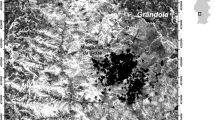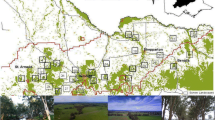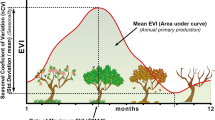Abstract
Most animal ecology studies using remote sensing data have assessed how environmental characteristics shape animal abundance, distribution, or behavior. But the increasing availability of high-resolution data offers new opportunities to study how animals, in turn, shape ecosystems at diverse scales. We evaluate the efficacy of using Sentinel-2 satellite imagery to quantify the effects of Arctic fox (Vulpes lagopus) denning activity (nutrient accumulation, bioturbation) on vegetation. Using an imagery-derived metric (NDVI), we compared maximum plant productivity and plant phenology patterns on 84 Arctic fox dens vs. reference sites, i.e., points generated within preferred denning habitat areas (predicted from a habitat selection analysis). We show that high-resolution imagery can be used to measure the effects of Arctic fox denning activity on vegetation. Plant productivity and the rate of green up were both greater on fox dens compared to reference (preferred-habitat) sites. Productivity on reference sites was lower than average productivity on the tundra (i.e., random sites), indicating foxes primarily establish dens in low-productivity areas. Plant productivity on dens was also unrelated to recent occupancy patterns, indicating fox denning activity has long-term legacy effects on plants that last beyond the lifetime of foxes. Our findings support Arctic foxes being classified as ecosystem engineers in low-Arctic tundra ecosystems by converting low-productivity sites into relatively high-productivity sites through their denning activity. We demonstrate the efficacy of using remote sensing technologies to study how predators increase landscape heterogeneity and influence ecosystem dynamics through patch-scale mechanisms, and ultimately advance our understanding of animal functional roles.




Similar content being viewed by others
Data Availability
Due to the sensitive nature of Arctic fox dens, specific location data is only available upon request from the authors. Otherwise, all other data and code used in this study are available as supplementary information files.
References
Aikens EO, Kauffman MJ, Merkle JA, Dwinnell SPH, Fralick GL, Monteith KL. 2017. The greenscape shapes surfing of resource waves in a large migratory herbivore. Ecology Letters 20:741–750.
Alessandrini C, Scridel D, Boitani L, Pedrini P, Brambilla M. 2022. Remotely sensed variables explain microhabitat selection and reveal buffering behaviours against warming in a climate-sensitive bird species. Remote Sensing in Ecology and Conservation 8:615–628.
Angerbjörn A, Tannerfeldt M, Erlinge S. 1999. Predator-prey relationships: arctic foxes and lemmings. Journal of Animal Ecology 68:34–49.
Asner GP, Levick SR. 2012. Landscape-scale effects of herbivores on treefall in African savannas. Ecology Letters 15:1211–1217.
Asner GP, Levick SR, Kennedy-Bowdoin T, Knapp DE, Emerson R, Jacobson J, Colgan MS, Martin RE. 2009. Large-scale impacts of herbivores on the structural diversity of African savannas. Proceedings of the National Academy of Sciences 106:4947–4952.
Asner GP, Vaughn N, Smit IPJ, Levick S. 2016. Ecosystem-scale effects of megafauna in African savannas. Ecography 39:240–252.
Bartoń KA, Zalewski A. 2007. Winter severity limits red fox populations in Eurasia. Global Ecology and Biogeography 16:281–289.
Bates D, Mächler M, Bolker B, Walker S. 2015. Fitting linear mixed-effects models using lme4. Journal of Statistical Software 67:1–48.
Ben-David M, Bowyer RT, Duffy LK, Roby DD, Schell DM. 1998. Social behavior and ecosystem processes: river otter latrines and nutrient dynamics of terrestrial vegetation. Ecology 79:2567–2571.
Bêty J, Gauthier G, Giroux J-F, Korpimäki E. 2001. Are goose nesting success and lemming cycles linked? Interplay between nest density and predators. Oikos 93:388–400.
Bêty J, Gauthier G, Korpimäki E, Giroux J-F. 2002. Shared predators and indirect trophic interactions: lemming cycles and arctic-nesting geese. Journal of Animal Ecology 71:88–98.
Bischof R, Loe LE, Meisingset EL, Zimmermann B, Van Moorter B, Mysterud A. 2012. A migratory Northern ungulate in the pursuit of spring: jumping or surfing the green wave? The American Naturalist 180:407–424.
Bokhorst S, Convey P, Aerts R. 2019. Nitrogen inputs by marine vertebrates drive abundance and richness in Antarctic terrestrial ecosystems. Current Biology 29:1721–1727.
Boyce MS, Vernier PR, Nielsen SE, Schmiegelow FKA. 2002. Evaluating resource selection functions. Ecological Modelling 157:281–300.
Bruun HH, Österdahl S, Moen J, Angerbjörn A. 2005. Distinct patterns in alpine vegetation around dens of the Arctic fox. Ecography 28:81–87.
Bump JK, Peterson RO, Vucetich JA. 2009. Wolves modulate soil nutrient heterogeneity and foliar nitrogen by configuring the distribution of ungulate carcasses. Ecology 90:3159–3167.
Chesemore DL. 1969. Den ecology of the Arctic fox in Northern Alaska. Canadian Journal of Zoology 47:121–129.
Clermont J, Grenier-Potvin A, Duchesne É, Couchoux C, Dulude-de Broin F, Beardsell A, Bêty J, Berteaux D. 2021. The predator activity landscape predicts the anti-predator behavior and distribution of prey in a tundra community. Ecosphere 12:e03858.
Crait JR, Ben-David M. 2007. Effects of river otter activity on terrestrial plants in trophically altered yellowstone lake. Ecology 88:1040–1052.
Dalerum F, Tannerfeldt M, Elmhagen B, Becker D, Angerbjörn A. 2002. Distribution, morphology and use of arctic fox Alopex lagopus dens in Sweden. Wildlife Biology 8:185–192.
Davies AB, Asner GP. 2014. Advances in animal ecology from 3D-LiDAR ecosystem mapping. Trends in Ecology & Evolution 29:681–691.
Davies AB, Gaylard A, Asner GP. 2018. Megafaunal effects on vegetation structure throughout a densely wooded African landscape. Ecological Applications 28:398–408.
Environment Climate Change Canada (ECCC). 2022. Climate normals 1981–2010 for the Churchill, MB station. Accessed 4 Aug 2022.
ESRI. 2022. ArcGIS Pro version 2.8. Redlands, CA.
Evans KL, Newson SE, Storch D, Greenwood JJD, Gaston KJ. 2008. Spatial scale, abundance and the species–energy relationship in British birds. Journal of Animal Ecology 77:395–405.
Fafard PM, Roth JD, Markham JH. 2020. Nutrient deposition on Arctic fox dens creates atypical tundra plant assemblages at the edge of the Arctic. Journal of Vegetation Science 31:173–179.
Fairfax E, Whittle A. 2020. Smokey the Beaver: beaver-dammed riparian corridors stay green during wildfire throughout the western USA. Ecological Applications 30:e02225.
Fariña JM, Salazar S, Wallem KP, Witman JD, Ellis JC. 2003. Nutrient exchanges between marine and terrestrial ecosystems: the case of the Galapagos sea lion Zalophus wollebaecki. Journal of Animal Ecology 72:873–887.
Farwell LS, Gudex-Cross D, Anise IE, Bosch MJ, Olah AM, Radeloff VC, Razenkova E, Rogova N, Silveira EMO, Smith MM, Pidgeon AM. 2021. Satellite image texture captures vegetation heterogeneity and explains patterns of bird richness. Remote Sensing of Environment 253:112175.
Fedriani JM, Garrote PJ, Delgado MdM, Penteriani V. 2015. Subtle gardeners: inland predators enrich local topsoils and enhance plant growth. PLoS ONE 10:e0138273.
Gable TD, Johnson-Bice SM, Homkes AT, Windels SK, Bump JK. 2020. Outsized effect of predation: wolves alter wetland creation and recolonization by killing ecosystem engineers. Science Advances 6:abcd5439.
Garrott RA, Eberhardt LE, Hanson WC. 1983. Arctic fox den identification and characteristics in Northern Alaska. Canadian Journal of Zoology 61:423–426.
Geremia C, Merkle JA, Eacker DR, Wallen RL, White PJ, Hebblewhite M, Kauffman MJ. 2019. Migrating bison engineer the green wave. Proceedings of the National Academy of Sciences USA 116:25707–25713.
Gharajehdaghipour T, Roth JD. 2018. Predators attract prey through ecosystem engineering in the Arctic. Ecosphere 9:e02077.
Gharajehdaghipour T, Roth JD, Fafard PM, Markham JH. 2016. Arctic foxes as ecosystem engineers: increased soil nutrients lead to increased plant productivity on fox dens. Scientific Reports 6:24020.
Hastings A, Byers JE, Crooks JA, Cuddington K, Jones CG, Lambrinos JG, Talley TS, Wilson WG. 2007. Ecosystem engineering in space and time. Ecology Letters 10:153–164.
Hawker L, Uhe P, Paulo L, Sosa J, Savage J, Sampson C, Neal J. 2022. A 30 m global map of elevation with forests and buildings removed. Environmental Research Letters 17:024016.
Holtgrieve GW, Schindler DE, Jewett PK. 2009. Large predators and biogeochemical hotspots: brown bear (Ursus arctos) predation on salmon alters nitrogen cycling in riparian soils. Ecological Research 24:1125–1135.
Hurlbert Allen H, Haskell JP. 2003. The effect of energy and seasonality on avian species richness and community composition. The American Naturalist 161:83–97.
Iles DT, Rockwell RF, Matulonis P, Robertson GJ, Abraham KF, Davies JC, Koons DN. 2013. Predators, alternative prey and climate influence annual breeding success of a long-lived sea duck. Journal of Animal Ecology 82:683–693.
Johnson-Bice SM, Gable TD, Roth JD, Bump JK. 2023. Patchy indirect effects of predation: predators contribute to landscape heterogeneity and ecosystem function via localized pathways. Oikos. (In press).
Jones CG, Lawton JH, Shachak M. 1994. Organisms as ecosystem engineers. Oikos 69:373–386.
Kieran CN, Obrist DS, Muñoz NJ, Hanly PJ, Reynolds JD. 2021. Links between fluctuations in sockeye salmon abundance and riparian forest productivity identified by remote sensing. Ecosphere 12:e03699.
Koma Z, Seijmonsbergen AC, Grootes MW, Nattino F, Groot J, Sierdsema H, Foppen RPB, Kissling WD. 2022. Better together? Assessing different remote sensing products for predicting habitat suitability of wetland birds. Diversity and Distributions 28:685–699.
Kucheravy CE, Roth JD, Markham JH. 2021. Red foxes increase reproductive output of white spruce in a non-mast year. Basic and Applied Ecology 51:11–19.
Kurek P, Kapusta P, Holeksa J. 2014. Burrowing by badgers (Meles meles) and foxes (Vulpes vulpes) changes soil conditions and vegetation in a European temperate forest. Ecological Research 29:1–11.
Lang JA, Roth JD, Markham JH. 2021. Foxes fertilize the subarctic forest and modify vegetation through denning. Scientific Reports 11:3031.
Lenth R. 2022. Emmeans: estimated marginal means, aka least-squares means. R package version 1.7.5. https://CRAN.R-project.org/package=emmeans.
Macpherson AH. 1969. The dynamics of Canadian arctic fox populations. Ottawa, CA: Canadian Wildlife Service Report Series. p 52.
McDonald RS, Roth JD, Baldwin FB. 2017. Goose persistence in fall strongly influences Arctic fox diet, but not reproductive success, in the Southern Arctic. Polar Research 36(sup1):5.
Merkle JA, Monteith KL, Aikens EO, Hayes MM, Hersey KR, Middleton AD, Oates BA, Sawyer H, Scurlock BM, Kauffman MJ. 2016. Large herbivores surf waves of green-up during spring. Proceedings of the Royal Society B: Biological Sciences 283:20160456.
Monk JD, Schmitz OJ. 2022. Landscapes shaped from the top down: predicting cascading predator effects on spatial biogeochemistry. Oikos 2022:e08554.
Natural Resources Canada. 2019. 2015 Land cover of Canada. Canada Centre for Remote Sensing, Natural Resources Canada. Government of Canada.
Nieto S, Flombaum P, Garbulsky MF. 2015. Can temporal and spatial NDVI predict regional bird-species richness? Global Ecology and Conservation 3:729–735.
Ostertag R, DiManno NM. 2016. Detecting terrestrial nutrient limitation: a global meta-analysis of foliar nutrient concentrations after fertilization. Frontiers in Earth Science 4:23.
Pedersen EJ, Miller DL, Simpson GL, Ross N. 2019. Hierarchical generalized additive models in ecology: an introduction with mgcv. PeerJ 7:e6876.
Pettorelli N, Laurance WF, O’Brien TG, Wegmann M, Nagendra H, Turner W. 2014. Satellite remote sensing for applied ecologists: opportunities and challenges. Journal of Applied Ecology 51:839–848.
Pettorelli N, Ryan S, Mueller T, Bunnefeld N, Jedrzejewska B, Lima M, Kausrud K. 2011. The normalized difference vegetation index (NDVI): unforeseen successes in animal ecology. Climate Research 46:15–27.
Pettorelli N, Vik JO, Mysterud A, Gaillard J-M, Tucker CJ, Stenseth NC. 2005. Using the satellite-derived NDVI to assess ecological responses to environmental change. Trends in Ecology & Evolution 20:503–510.
R Core Team. 2022. R: a language and environment for statistical computing [Version 4.2]. Vienna, Austria: R Foundation for Statistical Computing.
Risch AC, Frossard A, Schütz M, Frey B, Morris AW, Bump JK. 2020. Effects of elk and bison carcasses on soil microbial communities and ecosystem functions in Yellowstone, USA. Functional Ecology 34:1933–1944.
Ritchie JC. 1956. The native plants of Churchill, Manitoba, Canada. Canadian Journal of Botany 34:269–320.
Roberts DR, Bahn V, Ciuti S, Boyce MS, Elith J, Guillera-Arroita G, Hauenstein S, Lahoz-Monfort JJ, Schröder B, Thuiller W, Warton DI, Wintle BA, Hartig F, Dormann CF. 2017. Cross-validation strategies for data with temporal, spatial, hierarchical, or phylogenetic structure. Ecography 40:913–929.
Roth JD. 2003. Variability in marine resources affects arctic fox population dynamics. Journal of Animal Ecology 72:668–676.
Sawyer H, Kauffman MJ. 2011. Stopover ecology of a migratory ungulate. Journal of Animal Ecology 80:1078–1087.
Schmitz OJ, Hawlena D, Trussell GC. 2010. Predator control of ecosystem nutrient dynamics. Ecology Letters 13:1199–1209.
Schulte Bühne H, Pettorelli N. 2018. Better together: integrating and fusing multispectral and radar satellite imagery to inform biodiversity monitoring, ecological research and conservation science. Methods in Ecology and Evolution 9:849–865.
Sella GF, Stein S, Dixon TH, Craymer M, James TS, Mazzotti S, Dokka RK. 2007. Observation of glacial isostatic adjustment in “stable” North America with GPS. Geophysical Research Letters. https://doi.org/10.1029/2006GL027081.
Simpson GL. 2022. Gratia: Graceful ggplot-based graphics and other functions for GAMS fitted using mgcv. R package version 0.7.3.18. https://gavinsimpson.github.io/gratia/.
Smith CAS, Smits CMM, Slough BG. 1992. Landform selection and soil modifications associated with Arctic fox (Alopex lagopus) den sites in Yukon Territory, Canada. Arctic and Alpine Research 24:324–328.
Smits CMM, Smith CAS, Slough BG. 1988. Physical characteristics of Arctic Fox (Alopex lagopus) dens in Northern Yukon Territory, Canada. Arctic 41:12–16.
Speed JDM, Skjelbred IÅ, Martin MD, Berteaux D, Bueno CG, Christie KS, Forbes BC, Forbey J, Fortin D, Grytnes J-A, Hoset KS, Lecomte N, Marteinsdóttir B, Mosbacher JB, Pedersen ÅØ, Ravolainen V, Rees EC, Skarin A, Sokolova NA, Thornhill AH, Tombre I, Soininen EM. 2019. Trophic interactions and abiotic factors drive functional and phylogenetic structure of vertebrate herbivore communities across the Arctic tundra biome. Ecography 42:1152–1163.
Tognelli MF, Kelt DA. 2004. Analysis of determinants of mammalian species richness in South America using spatial autoregressive models. Ecography 27:427–436.
Turner W, Rondinini C, Pettorelli N, Mora B, Leidner AK, Szantoi Z, Buchanan G, Dech S, Dwyer J, Herold M, Koh LP, Leimgruber P, Taubenboeck H, Wegmann M, Wikelski M, Woodcock C. 2015. Free and open-access satellite data are key to biodiversity conservation. Biological Conservation 182:173–176.
Valerio F, Ferreira E, Godinho S, Pita R, Mira A, Fernandes N, Santos SM. 2020. Predicting microhabitat suitability for an endangered small mammal using Sentinel-2 data. Remote Sensing 12:562.
van Moorter B, Bunnefeld N, Panzacchi M, Rolandsen CM, Solberg EJ, Sæther B-E. 2013. Understanding scales of movement: animals ride waves and ripples of environmental change. Journal of Animal Ecology 82:770–780.
Wood SN. 2011. Fast stable restricted maximum likelihood and marginal likelihood estimation of semiparametric generalized linear models. Journal of the Royal Statistical Society: Series B (statistical Methodology) 73:3–36.
Zhao S-T, Johnson-Bice SM, Roth JD. 2022. Foxes engineer hotspots of wildlife activity on the nutrient-limited Arctic tundra. Global Ecology and Conservation 40:e02310.
Zupanc A. 2017. Improving cloud detection with machine learning. https://medium.com/sentinel-hub/improving-cloud-detection-with-machine-learning-c09dc5dgfcx7cf13. Accessed 7 May 2022.
Acknowledgements
We acknowledge salary and stipend support provided by the University of Manitoba. Support in locating and monitoring Arctic fox dens was provided by the Natural Sciences and Engineering Research Council of Canada, Natural Resources Canada Polar Continental Shelf Program, University of Manitoba Fieldwork Support Program, the Churchill Northern Studies Centre Northern Research Fund, and the many students that hiked out to dens as part of the Churchill Fox Project long-term research and monitoring efforts. Finally, we thank comments from two anonymous reviewers that improved the manuscript.
Author information
Authors and Affiliations
Corresponding author
Supplementary Information
Below is the link to the electronic supplementary material.
Rights and permissions
Springer Nature or its licensor (e.g. a society or other partner) holds exclusive rights to this article under a publishing agreement with the author(s) or other rightsholder(s); author self-archiving of the accepted manuscript version of this article is solely governed by the terms of such publishing agreement and applicable law.
About this article
Cite this article
Johnson-Bice, S.M., Roth, J.D. & Markham, J.H. A Cosmic View of ‘Tundra Gardens’: Satellite Imagery Provides a Landscape-Scale Perspective of Arctic Fox Ecosystem Engineering. Ecosystems 26, 1670–1684 (2023). https://doi.org/10.1007/s10021-023-00857-x
Received:
Accepted:
Published:
Issue Date:
DOI: https://doi.org/10.1007/s10021-023-00857-x




